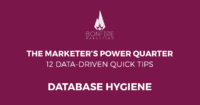Personas are critical for the success of your marketing efforts, digital or not. Strong personas are a reference for every department in your company or agency — from strategy to design, to content marketing and even business development. Without a clear understanding of your target audience, you’re wasting time, hard work, and money. Not to mention you’re missing an opportunity to truly engage and resonate with your audience.
“Strong personas are a reference for every department in your company or agency.”
 Click to Tweet
Click to Tweet
We’ve explored in a past Metrics Monday post how to effectively utilize your personas for different marketing platforms. But how do you create personas to begin with? In this post, we break down steps for how to use different Google Analytics reports for persona building.
Step 1: Build a persona template
At Bonfire, we start with a basic template to help guide us as we build a persona. We focus on geographic, demographic, psychographic, and behavioral attributes as the core of our framework.

The template may change based on the client or your company. For example, religious affiliation isn’t needed for B2B in the majority of cases. And you’ll want to go deeper into each of the attributes than what appears above, adding more attributes.
Most importantly, creating personas is based on data and not make-believe characters. Leave Snow White to the dwarfs.
Google Analytics is just one of many tools we use to develop personas at Bonfire.
Step 2: View clean Google Analytics data
You’ll need to examine at least six months to a year’s worth of Google Analytics data to get a grasp of your website users and how they fit into your persona building. It’s also important to ensure you’re viewing clean data. There should be filters in place excluding any internal traffic from specific IP addresses, as well as setting up advanced segments to remove spam traffic.
Step 3: Enable advertising features
You won’t get far in your analysis if you haven’t enabled advertising features in GA, which collects data via a third-party DoubleClick cookie and other sources. Without doing so, you won’t receive access to certain reports, like Demographics, Interests, and Multi-Channel Funnels.
You also need to have a Google AdWords account set up. Even if you don’t plan on launching ads, set AdWords up and sync it with your GA account first.
Next, navigate to the Admin tab at the top of GA. Select Tracking Info from the Property column and Data Collection. Turn on Advertising Reporting Features.

The final step is to navigate to Property Settings under Property, and locate Advertising Features. Turn on enabling of Demographics and Interests Reports.
Step 4: Analyze Google Analytics Audience Reports
The Audience Reports in GA hit right on the demographic and geographic attributes of your persona.
The Demographics’ Overview Report gives a quick visual of leading age groups and gender of your audience.

Don’t stop there. Drill down into each of the Age and Gender Reports. You may find that while one group has a higher number of sessions, another may be more engaged with your site’s content.
Do you have goals setup? How do they compare between age groups and gender? Does one group convert at a higher rate than others?
Select an age group, and you’ll pull up the gender breakdown. Add a Secondary Dimension, like Source/Medium for better understanding.
For the Gender Report, you may want to see which social network resonates with one gender versus the other, or even for a particular age group. All this and more is available as a Secondary Dimension.
Similarly, you can add a Segment to reveal even more about your primary audience and personas. Or you can create an advanced segment based on your primary age and gender data, and conduct a behavioral analysis focusing solely on this segment.
Step 5: Determine where your audience is located
There’s probably no doubt what language your primary audience and personas speak. So unless you have a business objective — like targeting Latinos — or you’re trying to build a business case for adding a second language to your website, you can quickly review the Language Report under Geo and move on.
The Location Report is insightful. Select the No. 1 location. For Bonfire, not surprisingly, it’s the United States. Once selected, you get a state-by-state breakdown of your website audience. And by selecting a state, you get even more granular state data, such as city or metro area.
If you’ve been tracking GA data for years, it’s really interesting to see how locations may have changed over time. For instance, if you’d asked what’s the second most popular region for Bonfire’s audience, I would’ve answered Washington off the top of my head. In truth, the past year of data reveals it’s California. And surprisingly Virginia is high on the list, too.
Step 6: Keep going and compare
Don’t stop with the reports covered above. You’ll want to analyze other Audience Reports to create a fuller picture of your personas, like interests and mobile preferences. The more detail and data-backed your personas are, the better.
Take the data you collect in GA and compare it to other tools and sources. Flesh it out and give life to your personas. In the end, your personas are actionable tools for your entire organization.
Related resources:
More Content
How to Create Personas With Google Analytics
Personas are critical for the success of your marketing efforts, digital or not. Strong personas are a reference for every department in your company or agency — from strategy to
The Marketer’s Power Quarter: Updating Lead Databases
This is the tenth in a 12-part series of quick-fix tips to improve your digital marketing results. Catch up on our last tip, and subscribe to our newsletter to get the
AI in Marketing: How to Get Started in 2018
One of the biggest buzzwords in marketing, and really across many industries, is artificial intelligence. For years, a majority of the public viewed AI as science fiction, but that’s starting




Leave A Comment